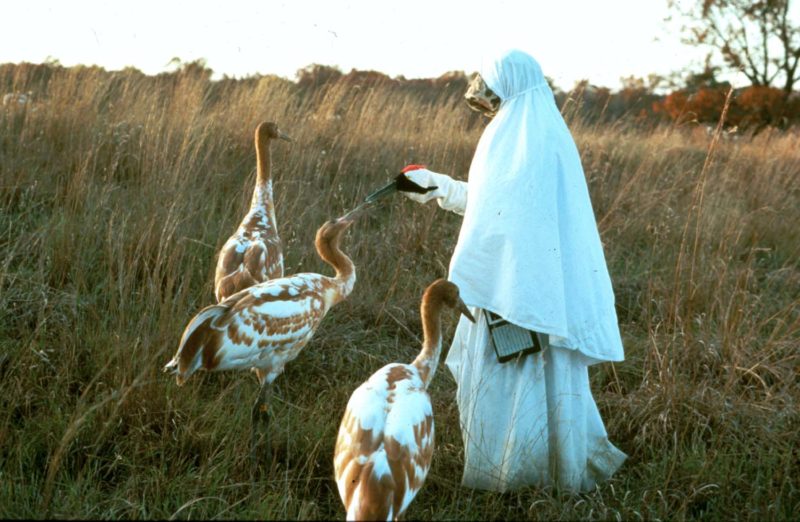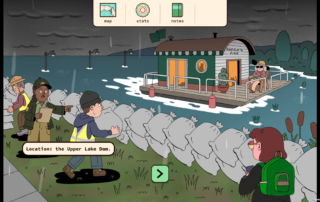The International Crane Foundation, based in Baraboo, works around the world to save cranes. Producer Breann Schossow spent a day in at its headquarters learning about its conservation work with whooping cranes.
I’m grinning from ear to ear.
“How long ago did the chick hatch?” I ask.
“20 minutes, maybe,” said Bryant Tarr, curator of birds for the International Crane Foundation. “15 minutes, maybe. Just out.”
The newly hatched Whooping Crane chick is part of just one of the foundation’s efforts to save cranes. But more on that in a minute.
Long before the egg is created, efforts in breeding Whooping Cranes include making sure a potential chick will have the best possible genetics, matchmaking, and more, experts at the foundation say. According to the foundation, a strongly bonded pair is necessary because a female crane often cannot produce eggs unless she has a strong bond with her mate.
The period of time when whooping cranes build nests and lay eggs runs from mid-to-late April to early June. Ideally, the eggs, which for whooping cranes have an incubation length of about 29 days, are kept under real birds for the first half – or so – of incubation.
“There’s something magical that happens under real birds that we can’t duplicate with machines,” Tarr said “You just get better hatchability if it’s under a real bird first.”
When the chicks reach hatching time, Tarr said, “they start peeping inside the shell, so they internally pip, they go through the membrane of the shell but not through the shell itself, and so we can listen,” Tarr said. “We put them on the counter and we play a bird call to them, a brood call, and they jiggle around on the counter, and we know, ‘Hey, I’m about to hatch’ … This bird has been in the other room for two days when it started peeping, then it pipped, which is, it makes that first little whole in the shell, and then it rests for about 24 hours, and then the next day it just saws its way around and then just pops out, and that’s what just happened.”
It’s noisy where the chick is kept because of the machines in the room, but we’re silent. Tarr lets me peek in the incubator at the chick after turning out the lights so he – or she – can’t see me. The chick, which hatched June 18, is damp, brown, and maybe a little bigger than a tennis ball and shows no signs, yet, of the snowy plumage it’ll one day have.
The chick will later be named Phantom, following this year’s theme of naming the whooping crane chicks after Wisconsin lakes. She is part of the foundation’s Direct Autumn Release program, which began in 2005 and will spend the next few months learning how to be a crane from scientists wearing crane suits. Costume-rearing helps the chicks avoid imprinting on humans and is something the foundation began experimenting with in the 1980s.
The International Crane Foundation, which works around the world to save cranes and do valuable conservation work, got its start in the 1970s, when Ron Sauey and George Archibald were classmates at Cornell University. Both were working on their doctorate degrees and both were interested in cranes, said International Crane Foundation Crane Research Coordinator Anne Lacy.
“They were very passionate about a family of birds that are very, very endangered globally and they thought, we need to do something, we want to do something, and Ron thought, ‘Well, my parents have a horse farm in Baraboo. Maybe we can go there.’ And they (the Sauey family) were gracious enough to let these two kids start this little experiment of saving cranes on their farm in Baraboo, Wisconsin.”
Today, that mission is continued around the world.
“We’re … working to save cranes and to work, build from the love and the cultural connections that people have with cranes to do big things, to try and save the landscapes the birds live in and broader areas where they are,” said Rich Belfus, president and CEO of the foundation. “There’s 11 of 15 crane species around the world that are endangered and we’re working very hard to save those, but we work with people everywhere who are passionate about cranes to try and achieve conservation successes for them.”
Efforts range from working on water issues in the Zambezi River basin in southern Africa to breeding and release programs involving Whooping Cranes and more.
Back in Baraboo, Phantom and her fellow chicks in the Direct Autumn Release program will be learning from humans in costume, along with adult crane role models, about how to be cranes.
The costumes are white — although gray costumes are worn during times when the chicks need to be examined — and cover people from head to toe.
A puppet is worn on one of the person’s hands that resembles a crane’s head, and there’s absolutely no talking. The people also carry MP3 players to play sounds a parent crane would make for chicks. According to the foundation, though, the chicks know there’s a difference between themselves and their caretakers because their hierarchy — and their social interactions — change based on who is wearing the costume.
Lead aviculturist and chick rearing supervisor Marianne Wellington said she’s learned a lot from other species on what she should and shouldn’t do in costume, or what she can and can’t do. Here’s an example she gave about what it’s like being in costume:
“… when you’re wearing a costume, your puppet is on your hand, and so you need to think about the fact that your hand acts like a head, and so your hand has to be looking at different things, and when an airplane goes over, you cock your head a little bit so that one eye is looking up at the airplane or at the hawk flying over,” she said. “If it’s a hawk, or something they’re not sure about, they’ll start watching longer and longer and you’re like oh, what is that … and so you just need to learn to freeze, and so for me … if i think about it correctly, it’s more of a Zen interaction, trying to be a crane as much as I can.”
In the fall, the Whooping Crane chicks are released near older cranes so they can learn the migration route south.
“It’s the exciting time because you get to see them behave like cranes, and you hope that you’ve done a great job at teaching them things that they can survive on in the wild, natural instincts will kick in … and then we find out what we can change and what we can’t change in our rearing methods and hope that they do great,” Wellington said. “So it’s a time of lots of emotions, so you’re sad because you’re letting these animals that you were working with so much, you get attached to them, it’s hard not to, you get attached to them so it’s sad to them go, but there’s this fantastic feeling to see them fly and I see them fly anyway, from day to day, taking them out, they fly and it’s amazing that they come back. It’s just amazing, but to see them fly and be cranes in the wild, it’s just fantastic.”
In early November of this year, eight Whooping Crane chicks were released. Two other chicks, one of which is Phantom, were kept for the foundation’s captive breeding program because of their good genetics. There are around 400 Whooping Cranes in the wild now, which has climbed since the 1940s when there were less than 20.











